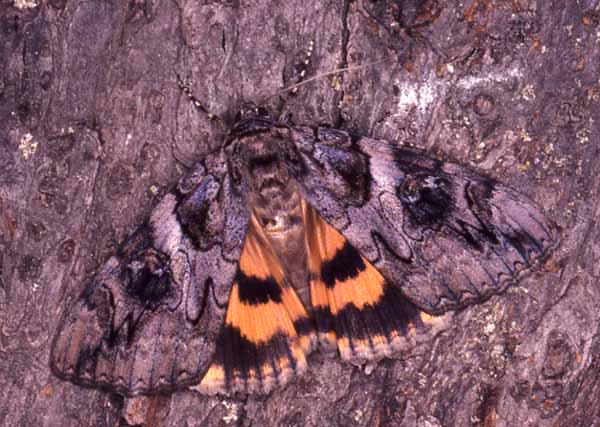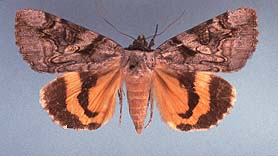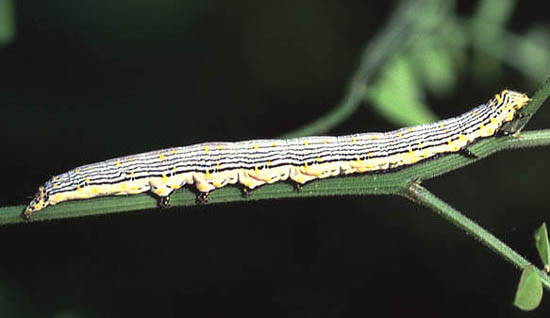Catocala amestris
kah-TOCK-uh-lahMa-MES-tris
Strecker, 1874

Catocala amestris, Florida,
courtesy of Leroy Simon.
This site has been created by
Bill Oehlke.
Comments, suggestions and/or additional information are welcomed by Bill.
| TAXONOMY:
Superfamily: Noctuoidea
Family: Erebidae, Leach, [1815]
Subfamily: Erebinae, Leach, [1815]
Tribe: Catocalini, Boisduval, [1828]
Genus: Catocala, Schrank, 1802
|
DISTRIBUTION: Catocala amestris,
the Three-staff Underwing (wingspan 43-50mm),
flies from
North Carolina south to
Florida and west to
Texas and
Oklahoma.
It is reported as endangered in
Michigan and
Illinois and possibly in
other states north of the Carolinas.
It has also been reported in eastern South Dakota: Clay County: Vermillion (Tom Middagh) and in
Manitoba: Winnipeg (Richard Westwood).
it has also been reported in
Arkansas,
Colorado,
Georgia,
Indiana,
Kansas,
Minnesota,
Missouri,
Nebraska,
North Dakota,
South Carolina,
Tennessee and
Wisconsin.
In form "westcotti" the outer black band is
complete. In others,
the band is broken as in abbreviatella.
Hindwing ground colour
is usually deeper yellow-orange than in similar species. | 
Catocala amestris "westcotti",
Georgia,
courtesy of James K. Adams. |

Catocala amestris form 'abbreviatella', Winnipeg, Manitoba,
courtesy of Richard Westwood, Dept. of Biology, University of Winnipeg.

Catocala amestris form 'westcotti', Winnipeg, Manitoba,
courtesy of Richard Westwood, Dept. of Biology, University of Winnipeg.
FLIGHT TIMES AND PREFERRED FOOD PLANTS:
Catocala amestris are usually on the wing from July through August.
The Catocala amestris caterpillar shows a preference for
Amorpha canescens, Amorpha fruticosa and
Robinia pseudoacacia.

Catocala amestris, Vermillion, Clay County, South Dakota,
46mm, July 30, 2008, courtesy of Tom Middagh.
ECLOSION:
Adults eclose from pupae at soil surface.

Catocala amestris, Buffalo County, Wisconsin,
July 17, 2013, courtesy of Marcie O'Connor.
SCENTING AND MATING:
Catocala amestris females
emit an airbourne pheromone and males use their antennae to track the
scent plume.

Catocala amestris, Vermillion, Clay County, South Dakota,
43mm, July 4, 2009, Mitch Marcotte, courtesy of Tom Middagh.

Catocala amestris (verso), Vermillion, Clay County, South Dakota,
43mm, July 4, 2009, Mitch Marcotte, courtesy of Tom Middagh.
EGGS, CATERPILLARS, COCOONS AND PUPAE:
Eggs are deposited on
tree bark in the fall and hatch the following spring.

Catocala amestris
final instar courtesy of J.K. Adams.
Larval Food Plants
Listed below are primary food plant(s) and alternate food plants.
It is hoped that this alphabetical listing followed by the common
name of the foodplant will prove useful. The list is not exhaustive,
although some species seem very host specific.
Experimenting with closely related foodplants is worthwhile.
Amorpha canescens
Amorpha fruticosa
Robinia pseudoacacia ......
|
Pursh/Lead plant
Desert False Indigo/Bastard Indigo/Indigo Bush
Black locust
|
Return to Main Index
This page is brought to you by Bill Oehlke and the
WLSS. Pages are on space rented from Bizland. If you would like to become a "Patron of the Sphingidae/Catocala Sites",
contact Bill.
Please send sightings/images to Bill. I will do my best to respond to requests for identification help.
Enjoy one of nature's wonderments: Live Saturniidae (Giant Silkmoth) cocoons.

Catocala amestris???, Estill County, Kentucky, August 7, 2010, courtesy of Sally Ramsdell.
I am fairly sure the moth depicted above is not amestris, but I am not sure yet as to what it is.

Catocala amestris, Chalkrock, Cedar County, Nebraska,
July 5, 2022, courtesy of Scott Wehrly.

|

To show appreciation for this site, click on the flashing
butterfly to the left, a link
to many worldwide insect sites. |












